
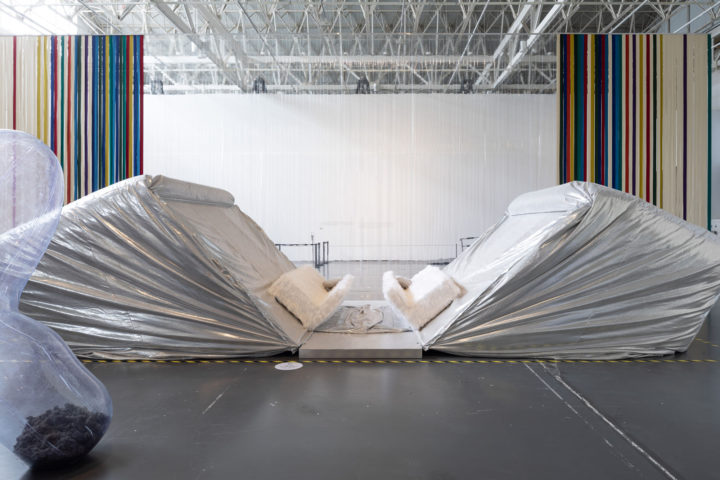
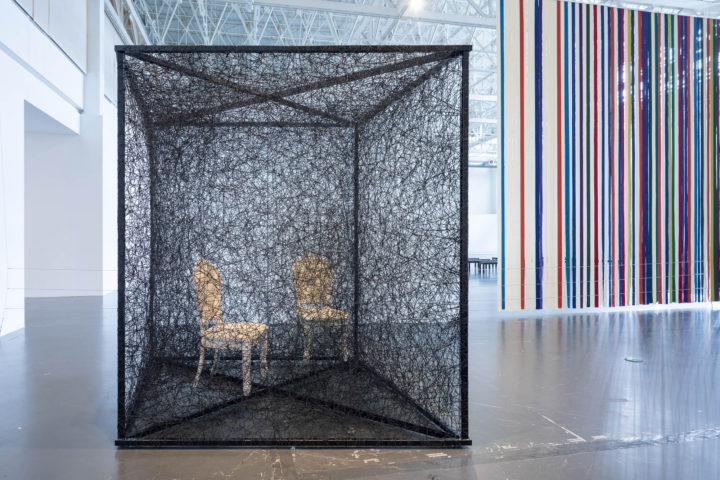
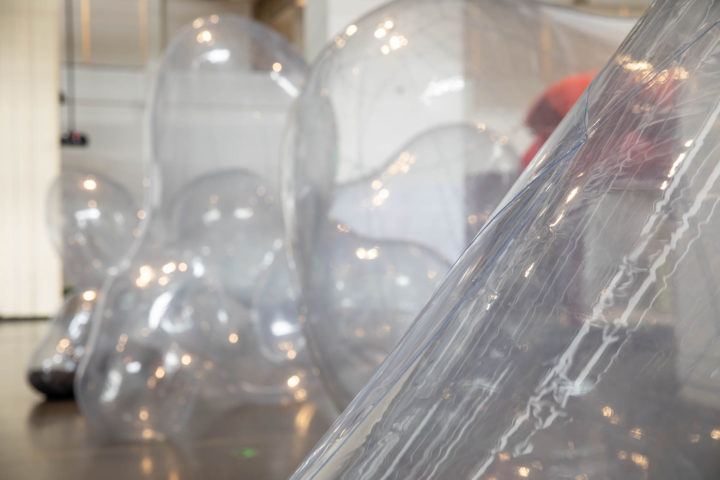
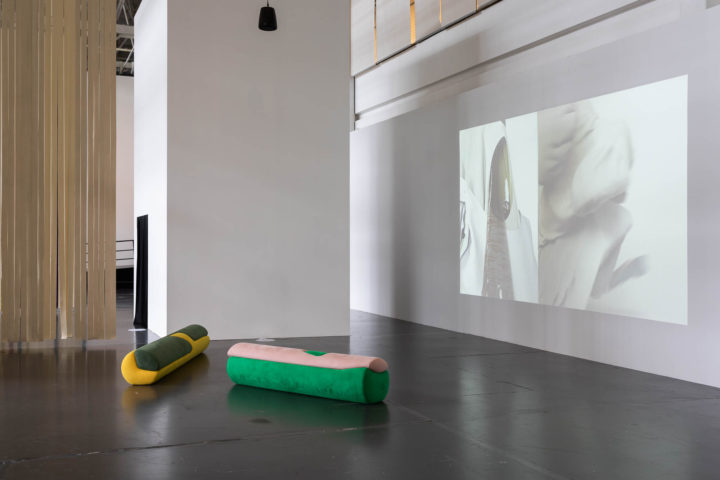


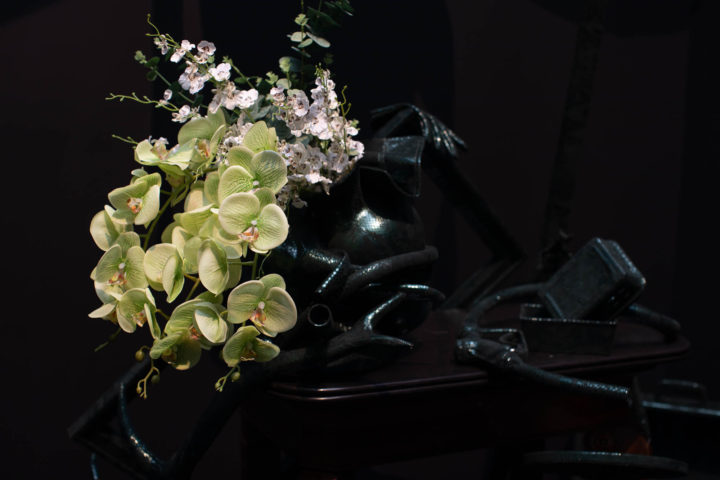

Yuz Museum: Nine Journeys Through Time
Duration: 2019 July 3 – October 7
Venue: Yuz Museum, No.35 Fenggu Road, Shanghai
The microscopic reality placed before us by Aaajiao, the zoomorphic geometries of Iris van Herpen. The world altered by the mysterious chimera of Andrea Anastasio and the thick spider webs of Chiharu Shiota. Zeitguised’s digital anamorphosis, the electronic universe of Caterina Barbieri and her synthesiser. The time in the fourth dimension, one beyond our experience and comprehension, as evoked by Li Shurui. The spatial and temporal references of the architecture enveloping the exhibition and which vanish in the room of Krijn de Koning but also the ephemeral performative space by Alex Schweder that envelops the viewer into a soft hug of intimacy and entrapment.
“Nine Journeys Through Time” is an exhibition organized by Yuz Museum together with Alcantara, and evolves from the eponymous show previously presented in the Apartment of the Prince, Royal Palace in Milan, conceived and co-curated by Davide Quadrio and Massimo Torrigiani in 2018.
“Nine Journeys Through Time” offers an exceptional combination of talents, 9 artistic approaches are brought together, expressing their visions through 9 projects in various artistic languages. From the transfiguration of painting into fashion, from digital design to music, they all draw inspiration from the specifics of a unique medium: Alcantara, analyzing all its various declinations and potential, exploring its invention and production processes, working with technicians and experts, be it along independent paths or through innovative collaboration projects.
The 9 artists are: Aaajiao, Andrea Anastasio, Caterina Barbieri, Krijn de Koning, Li Shurui, Alex Schweder, Chiharu Shiota, Iris van Herpen, and Zeitguised.
Each of them has come up with a site-specific work, initially dialoguing with the Royal Palace in Milan, itself a setting charged with great creative energy: a launch pad for journeys ranging from anomalous science laboratories, anacondas, mutations, sinusoids, oracular apparitions, twisting from the natural to the artificial and back again, psychedelic corridors and quirky metronomes. All this energy is mutated and transformed in the main exhibition hall of Yuz Museum in Shanghai.
Yuz Museum’s “Nine Journeys Through Time” is a development and includes new configurations of the works by Krijn De Koning, Chiharu Shiota and Aaajiao and introduces a new artist into the exhibition: Alex Schweder, an artist based in New York who adds a performative element into the dynamic of the show.
In this process of “moving” the show from Milan to Shanghai, all the precedent stories and complex interactions between the Apartment of the Prince and the artworks, will be narrated in a suspended time and space of an open space.
The big thread that keep the works together is first of all ‘time’ as it is the result of the dialogue between artists and material, artists and places, artists and curators. In this case, the original effect that Apartment of the Prince created, led the artists to a reflection on the various dimensions of time: on ‘our’ time, the everyday, practical and brief dimension, opposed (or complementary) to ‘scientific time’, dilated and imperceptible. Yuz Museum’s experience will add to that a strong feeling of space and architecture where the connections between the artworks and the art pieces will be highly performative and interactive, leaving to the public the pleasure of experiencing all the above in a very ludic and profound way. The work of Alex Schweder both spatial and performative surely will add into this scheme of the curatorial change in perspective. When the artworks are separated from the context they initiated, and entering the soaring museum great hall reconstructed on an old hangar, with white walls and gray flooring, the minimalist and open exhibition design will focus on the artworks themselves, opening up a new dialogue with time and space.
Along with the theme of time and thank to the shift of space and time (Milan versus Shanghai, time versus architecture), various perspectives emerge in the exhibition showing the relationship between natural and artificial, between products and nature, between us humans and that which is different from us. This is what gives that ‘research center’ feel to it all. This exhibition not only aims at how artists explore and cross the boundaries of art, but also allows spectators to keep thinking about the factors that influence the artists’ creations. Additionally, more questions will arise such as how cross-disciplinary cooperation is expanding the possibilities of artistic creation, and what does the most authentic art look like.
“Nine Journeys Through Time” is designed to provide an experiential journey, one to be undertaken by spirits willing to let themselves be enveloped in a sense of wonder. Each setting turns out to be a surprise that projects us into a sequence of diverse and enthralling space-time dimensions. A sophisticated experience, at times abstract yet never out of reach, which buffers us between changing worlds and startling aesthetic experiences.
Yuz Museum has always adhered to the founding tenet of “leading the world’s attention to Shanghai”; opening a window to the world for Chinese audiences and bridging the distance between distinct cultures and individuals. Simultaneously, the museum seeks to take advantage of various materials, media, and technology to extend the potential of art in the era of mechanical reproduction, explore the new possibilities of art as a result of modern science and modern practice, and blend into the lives of visitors through diverse interpretations. We are pleased to continue the museum’s curatorial concept through this exhibition and to provide a rich and artistic journey to the audience through interactive artworks by nine different artists.
——Justine Alexandria, Yuz Museum Acting CEO
We are very pleased to present this exhibition in a new configuration from the Royal Palace in Milan to the prestigious Yuz Museum in Shanghai. It is a true example of the strong Alcantara’s belief in the mutual exchange and contamination between Western and Eastern culture, in particular in the world of contemporary Art. This project clearly reaffirms our values and identity through a series of collaborations developing a unique approach with the world of art and building a genuine dialogue with artists, curators, museums and cultural institutions throughout the world.
——Andrea Boragno, Chairman and CEO of Alcantara S.p.A
THE EXHIBITION CONFIGURATION
For the show in Yuz Museum, the works will not be divided into rooms but will be sharing the same lofty space of the great hall of the museum. The artworks will be just in front of the eyes of the public creating among themselves interactions and layered meanings and connections. Only two works (by artist Andrea Anastasio and artist/designer Iris Van Herpen) will be enclosed into a sacred space, a temple or a spiritual room. So the works not necessarily in the order written here can be experienced by the visitors freely.
Desire by Aaajiao pushes the visitors into a clinical and microscopic spatial dimension, coming face to face with the fundamental unity of this extraordinary material. The time of its coming into being. Several large transparent organic-shaped capsules withhold a body with blurred edges to it, the initial phase of the production process of the eponymous material.
Iris van Herpen: Extended Indefinitely. A sculpture-garment, created through a painstaking crafts process applied to Alcantara material seems to place the visitor before the simulacrum of an unknown civilization, one from the future or some long forgotten era. The garment, a phantasmagorical presence, comes to life, reaching out into all directions in a dark setting.
Andrea Anastasio: Eden. Inspired by a giant anaconda, a metaphor for consumption society, gobbling up everything in its path, the work is presented as a synthesis of elements of industrial production, interspersed with splendid floral elements. The visitor is led along a path through a
landscape of urban furnishings, ennobled and transformed into living matter by a luxurious yet unsettling ‘skin’ – a python that has shed its skin, its scales all shiny. Objects common to every living creature today, both human and not. The omnivorous quality of luxury.
The dream of Chiharu Shiota: Reflection of Space and Time. Conceived as a universal place that preserves the memories of humanity, a thick monochromatic spider web – the distinctive sign of the production of the artist, which here uses 110 kilometres of thread of this unusual material applied during the installation stage – crosses and envelops an internal structure from which three iconic chairs stand out. Their image is reflected and multiplied in the mirrors positioned in the centre of the structure, altering the physical and temporal perception of the surrounding space, in a continuous toing and froing of views and illusions, of awakeness and dreaming.
Beyond the Nuclear Garden by the Berlin group Zeitguised. The work is the upshot of an algorithm developed especially for the occasion and that creates a pair of chairs/objects which stand in front of a screen where material’s textures are played around in a magical choreography. The work by Caterina Barbieri is a soundscape that enhance the sacrality of the two rooms occupied by Andrea Anastasio and Iris van Herpen. Her love for digital and analogical textures of sounds well reflects on the nature of the two installations. The same love which is also reflected in her meticulous research into the synthetic nature of sound. Barbieri processed a series of environmental recordings carried out in their production plant to create a soundtrack. This all makes us call into question the relationship between the human and the mechanical, the natural and the artificial, listening and sound. Rhythm is nothing if not the idea reproduction of the natural movement of life.
A large temple with a complex curved structure is the work by artist Li Shurui. Coated in Alcantara printed with the optical motifs that characterize the pictorial production of the artist, the Temple of Reverence for Knowledge Beyond Human Comprehension was designed in order for us to humbly entreat the fourth dimension and all those realms of existence beyond our knowledge and experience. So to assist us, by any possible means, in accepting our three-dimensional, linear and time-restrained clumsiness, and in expanding our consciousness.
The work Room by Krijn de Koning, with an operation of spatial estrangement which leads the visitors into a chamber entirely coated in various colours of the iconic material, of which the edges of the architectural spaces – doors, windows, passageways and geometric chambers – are superimposed onto the real space, thus creating a fictitious perception of time and space.
Alex Schweder’s new addition to the exhibition is called to Sofa to Bed to and offers the gift of respite to exhibitiongoers. Two at a time, each reclines on a furry sofa-like form. Shortly after their heads hit the pillows, air begins to fill the soft suede-like surface they walked upon to reach the center. A sparkling version of the extraordinary material continues to engorge; the sofas and their supine guests slowly rotate toward each other. Full now, the inflated forms have turned the backs of the sofas to form a momentary bed where strangers face one another intimately. Exhaling begets the end of this short closeness. Rotating in silence, returning to two, this space’s shimmering yawn beckons two more into its embrace.
About Yuz Museum Shanghai
Yuz Museum Shanghai, officially opened in May 2014, is a contemporary art museum founded by Mr. Budi Tek, a Chinese-Indonesian entrepreneur, philanthropist and collector. The museum is located in the core area of West Bund Shanghai, and plays an important role in “West Bund Culture Corridor”. Yuz Museum is committed to drawing the world’s attention to Shanghai, advancing the development of contemporary Chinese art, actively in the field of art education, and promoting cultural dialogues between the East and the West. As a non-profit institution, Yuz Museum aims to establish itself as a new landmark for exhibiting contemporary Chinese art and to be a preeminent contemporary art museum in the world.
Designed by acclaimed Japanese Architect, Sou Fujimoto, the museum was renovated from an old aircraft hangar site of the former Shanghai Aircraft Manufacturing Factory. The museum has a total area of 9,000 square meters, among which the hangar-converted great hall alone
covers over 3,000 square meters, complementing the numerous large-scale art installations, while the other galleries offer more than 1,000 square meters for paintings, sculptures and photography of contemporary art.
ABOUT ALCANTARA
Founded in 1972, Alcantara represents a prime example of Italian-produced quality. As registered trademark of Alcantara S.p.A. and result of a unique and proprietary technology, Alcantara® is a highly innovative material, offering an unrivalled combination of sensory, aesthetic and functional qualities. Thanks to its extraordinary versatility, Alcantara is the choice of leading brands in a number of application fields: fashion and accessories, automotive, interior design and home décor, consumer-electronics. These features, together with a serious and certified commitment in terms of sustainability, make Alcantara a true icon of contemporary lifestyle: the lifestyle of those who want to fully enjoy their everyday life, respecting the environment. Since 2009 Alcantara is certified ‘Carbon Neutral’, having defined, reduced and offset all the CO2 emissions derived from its activity. To mark out the path of the company in such a field, every year Alcantara draws up and publishes its own Sustainability Report, certified by BDO authority and available on the corporate website. Headquartered in Milan, Alcantara production site and R&D department are located in Nera Montoro (Terni) in the heart of Umbria Region.
CURATOR BIOGRAPHY
After having founded and directed the BizArt Center between 1998 and 2010, the first non-profit artistic/creative laboratory in Shanghai, where he lived from 1994 to 2017, in 2007 Davide Quadrio created Arthub: a platform dedicated to the production and promotion of contemporary art in Asia and throughout the world. In the arena of these experiences, he staged numerous exhibitions, teaching projects and cultural exchange programmes, fostering relationships between institutions around the world. This work led to the inclusion of BizArt as a special project in Art and China after 1989: Theater of the World at the Guggenheim in New York, 2017. From 2005 to 2008, he served as artistic director of the creative space Bund18 in Shanghai, where he curated the Chinese edition of the exhibition on Vivienne Westwood by the Victoria & Albert Museum, as well as the touring show on Droog Design (Shanghai, Shenzhen, Beijing), and the solo exhibition by Olivo Barbieri as part of the Shanghai Biennale, an institution for which in 2012 he coordinated the project ‘City Pavilions’. His most recent initiatives include: Bird Cage, a Temporary Shelter, Zhang Enli in Galleria Borghese, Rome (2019); the retrospective Journeys Without Arrivals by Qiu Zhijie, Vanabbe Museum, Centre d’Art Contemporaine de Geneve and Kunstalle Lund (2017-2018); the double solo show by Zhang Enli and Christopher Doyle at the Aurora Museum in Shanghai; the solo show by Paola Pivi Tulkus 1898-2018, Castello di Rivoli, Witte de With and Frac Dijon; the exhibition and film New Women by Yang Fudong for the Toronto Film Festival (2013); and the solo show by Jompet at the Fondazione Gervasuti di Venezia during the Venice Biennale (2011). As a curator of the Aurora Museum of Shanghai from 2013 to 2016, he curated a multi-faceted project New Roads, presenting several contemporary art interventions in the Museum (artists included: Li Mu, Yang Fudong, Francesco Vezzoli, Kan Xuan, Michael Lin, Yin Xiuzhen, Liu Shiyuan, Liu Jianhua, Li Shurui, Qiu Zhijie, Zhang Enli, Christoper Doyle among others); from 2015 to 2016 he curated the pop-up edition of the magazine Kaleidoscope Asia. Since September 2017 he is living in Milan.
ARTISTS BIOGRAPHY
Li Shurui
Born in 1981 in Chongqing, China, where she graduated from the Sichuan Fine Art Institute, she lives and works in Beijing. Li Shurui uses painting as a medium to explore the ways in which light and colour may reflect individual needs and desires in various times and cultures. Winner of the New York Fellowship Program of the Asian Cultural Council (ACC) in 2016, she has displayed her work in group shows at prestigious international institutions such as the Chinese Centre for Contemporary Art, Manchester (2018); New Galerie, Paris (2017); Georgian National Museum – Dimitri Shevardnadze National Gallery, Tbilisi (2017); National Museum of Women in the Arts, Washington D.C. (2016); Minsheng Art Museum, Shanghai (2016 and 2015); PAC – Padiglione d’Arte Contemporanea, Milan (2015); Asian Art Museum, San Francisco (2015); and the OCAT Contemporary Art Terminal, Xi’An (China, 2014). In 2018 she also designed a limited edition bag for Lady Dior Art
Chiharu Shiota
Born in Osaka in 1972. Lives and works in Berlin. Confronting fundamental human concerns such as life, death and relationships, Shiota explores human existence throughout various dimensions by creating an existence in the absence either in her large-scale thread installations that include a variety of common objects and external memorabilia or through her drawings, sculptures, photography and videos. In 2015, Shiota represented Japan at the 56th Venice Biennale and has exhibited her work in international institutions such as Gropius Bau, Berlin; The National Museum of Art, Osaka; Yorkshire Sculpture Park, Wakefield (UK); Power Station of Art, Shanghai; K21 Kunstsammlung Nordrhein-Westfalen, Düsseldorf; and the Art Gallery of South Australia, Adelaide. Furthermore, her work has been presented at the Sydney Biennale; Gwangju Biennale (South Korea); the Setouchi International Art Festival; and the Yokohama Triennale (Japan). In June 2019, a comprehensive solo exhibition will be shown at the Mori Art Museum, Tokyo.
Zeitguised
Zeitguised is an award winning studio producing exquisite realities, at the intersection where digital art and design cross physical space. With their conceptual approach to formal poetry they have been influencing synthetic image making since 2001, when Jamie Raap and Henrik Mauler founded the studio with a project encompassing VR and 3D printing. Their universe of digital animism is inhabited by character like abstractions, where hallucinative narratives of shape, color and behaviours make inanimate objects come to life.
After Chicago, Stuttgart and London, Zeitguised is now based in Berlin and branched out with a commercial service studio called “foam”. Apart from continuing to explore digital design work the studio started a series called “intersections”. It is home to original independent solo projects and artist collaborations in the material world of “phygital” objects.
Right from the beginning, thanks to an innovative and experimental approach to new technologies, the group’s work has been featured in a number of art fairs and festivals dedicated to new media, such as Onedotzero, Dotmov, Nemo, ITFS and Resfest, and has received numerous awards: nominated for two consecutive Media Art Awards at the ZKM in Karlsruhe (2001 and 2002), the group was given the prize for the best musical video at the International Cinema Festival of Oberhausen (2005), and in the same year, the Best Design Award at the Resfest. This was followed, in 2009, by the prize for the best experimental work at the Ottawa International Animation Festival and, in 2010, Zeitguised was shortlisted for the experimental section of the Vimeo Festival + Awards in New York; the group also won two Laus awards (2014 and 2015), and was given two mentions of honour at Ars Electronica (Linz); in 2016, the group was awarded the Best Experimental and Best VFX prizes at the Berlin Fashion Film Festival, and bronze from the Ciclope
Festival in Berlin. Zeitguised’s works have been displayed in museums and art events throughout the world.
Iris van Herpen
Born in the Netherlands in 1984, ever since her first fashion show in 2007 she has risen to international fame as one of the most innovative designers in the fashion world thanks to her unprecedented experimental creations. In her work, she uses traditional materials together with technologies and production techniques uncommon in the sartorial world, such as her pioneering use of 3D printing to breathe life into unique and visionary creations: an approach that she herself defines as ‘New Couture’. As well as numerous collaborations with artists, architects and scientific research centres (CERN and MIT), and her constant presence in the Paris Haute Couture calendar since 2011, her work has been presented in museum institutions such as the Victoria & Albert Museum (London), the Cooper Hewitt Museum (New York) and the Palais de Tokyo (Paris), as well as in a major touring retrospective in the United States. Some of her garments are to be found in the permanent collection of the MoMA in New York, and in the prestigious retrospective at the Metropolitan Museum of Art in New York, “Manus x Machina: Fashion in an Age of Technology.”
Aaajiao
Aaajiao lives and works in Shanghai and Berlin.
Active online as a media artist, blogger, activist and programmer, Aaajiao is the virtual persona of the artist Xu Wenkai. Born in 1984 – the title of George Orwell’s classic allegorical novel – and in one of China’s oldest cities, Xi’an, Aaajiao’s art and works are marked by a strong dystopian awareness, literati spirits and sophistication. Many of aaajiao’s works speak to new thinkings, controversies and phenomenon around the Internet, with specific projects focusing on the processing of data, the blogsphere and China’s Great Fire Wall. Aaajiao’s recent projects extend his practice to various disciplines (among them, architecture, topography, and design) to capture the pulse of the young generation consuming cyber technology and living in social media.
Aaajiao’s work has been featured in numerous exhibitions around the world, recent shows include“Art in the Age of the Internet, 1989 to Today”, The Institute of Contemporary Art Boston, Boston (2018); “unREAL”, Haus der elektronischen Künste, Basel (2017); “Body Media II”, Power Station of Art, Shanghai (2017);“Shanghai Project Part II”, Shanghai (2017); “Temporal Turn: Art and Speculation in Contemporary Asia”, Spencer Museum of Art, Kansas (2016); “Take Me (I’m Yours)” (curated by Hans Ulrich Obrist, Jens Hoffmann and Kelly Taxter), Jewish Museum, New York (2016); “Overpop”, Yuz Museum, Shanghai (2016); “Hack Space” (curated by Hans Ulrich Obrist and Amira Gad), K11 Art Foundation Pop-up Space, Hong Kong and chi K11 art museum, Shanghai (2016); “Globale: Global Control and Censorship”, ZKM | Centre for Art and Media, Karlsruhe (2015); “Thingworld International Triennial of New Media Art”, The National Art Museum of China, Beijing (2014); and Transmediale, Berlin (2010). His solo exhibitions include “a’a’a’jiao: an ID”, HOW Art Museum, Shanghai (2019); “Remnants of an Electronic Past”, Centre for Chinese Contemporary Art, Manchester (2016); OCAT Contemporary Art Terminal Xi’an, Xi’an (2016), among others.
He was awarded the Art Sanya Awards in 2014 Jury Prize and was nominated for the first edition of OCAT-Pierre Huber Art Prize in 2014.
Alex Schweder
Alex Schweder was born in New York City, 1970. He coined the term “Performance Architecture” in 2007 to describe his work that explores architectural space through questions arising from performance art. Schweder’s work in this conceptual territory has been exhibited at the Museum of Modern Art in New York, Performa 17, The Aldrich Contemporary Art Museum, Antarctopia at the 2014 Venice Biennale, The Tel Aviv Museum of Art, the 2013 Lisbon Architecture Biennial, Tate Britain, and the San Francisco Museum of Modern Art. The Kulturstiftung des Bundes, The Pollack Krasner Foundation, the Foundation of Contemporary Art, and the Graham Foundation have all funded Schweder’s projects. He has been an artist in residence at the Kohler Company, the Chinati Foundation, and The American Academy in Rome as the 2005-6 Rome Prize Fellow in Architecture and will be a 2020 fellow at Civitella Ranieri. Schweder’s work has been featured in publications that include Artforum, The New York Times, and Performance Now by RoseLee Goldberg.
Andrea Anastasio
Born in 1961 in Rome, he lives between Naples and Mumbai. After obtaining an M.A. in Oriental studies at the University of Ca’ Foscari in Venice, Italy, he embarked on numerous collaboration projects as a designer, a field in which he still works, for brands such as Artemide, Danese, Foscarini and Memphis, before moving to India in 1991. Alongside his professional activity, he devotes his time to his own artistic production; his works put forward a reappraisal of industrial design as a philosophy of living. Since 1990, his work has been displayed in numerous museums, galleries and events focusing on design such as: Fondazione Achille Castiglioni a Milano (2018), Palazzo Reale di Milano (2018), Italian Embassy in Stockholm (2018), Kogei Prefectural Museum of Art and Design of Toyama in Japan (2018), Fondazione Cini – Venezia (2018), MIC – Museo Italiano delle Ceramiche di Faenza (2017), Museo Poldi Pezzoli di Milano (2016), Museum of Fine Arts di Montreal and MART Museo di Arte Contemporanea di Rovereto (2007). He was Artist in Residence at the Isabella Stewart Gardner Museum in Boston, USA where he exhibited “Chairs” in 2005 together with Dayanita Singh and where in 2008 was involved in the performance “Reading Dante” with Joan Jonas, exhibited as a video at the 53 Biennale di Venezia in 2009. In 2017 he won the “Best light project” at Salone in Milano and the “Best light project” by American design and interior design press.
Caterina Barbieri
Caterina Barbieri is an Italian composer who explores themes related to machine intelligence and object-oriented perception in sound through a focus on minimalism. Barbieri explores the psycho- physical effects of repetition and pattern-based operations in music, by investigating the polyphonic and polyrhythmic potential of sequencers to draw severe, complex geometries in time and space.
Approaching music practice as an integrative cognitive feedback between humans and technology lies at the core of her sonic research, currently focused on the creative use of computation and complex sequencing techniques to explore the artefacts of human perception and ultimately induce a sense of ecstasy and contemplation.
Barbieri holds a diploma in classical guitar and a bachelor’s degree in electro-acoustic music from the Conservatory of Bologna, Italy, alongside a bachelor’s degree from the Faculty of Humanities and Philosophy of Bologna with a thesis in Ethnomusicology about Hindustani music and minimalism.
Since 2013 she has researched and produced music at Elektronmusikstudion in Stockholm, where she has intensively composed for the Buchla 200 system. Her first release Vertical, composed for Buchla 200 and vocals, was produced between Elektronmusikstudion and the Royal University of Music in Stockholm and released via Important Records’Cassauna offshoot (2014). Since then, her work has been presented in festivals and venues such as MaerzMusik and Atonal, Mutek, Unsound, Sonar, Barbican Centre, Philharmonie de Paris, CTM, Ableton Loop, Biennale di Venezia.
Her full-length debut album Patterns of Consciousness (Important Records, 2017) has received critical acclaim and been named in several ‘Best of 2017’ music round-ups (Fact Mag, The Wire, Boomkat etc.). 2017 saw her release also the debut album of her collaborative project with Carlo Maria, Punctum on Berlin’s imprint Summe. 2019 sees her release the LP Ecstatic Computation on Editions Mego and perform in contexts such as Primavera Sound, Sonar, Dekmantel, Maison de la Radio, Funkhaus, Rewire etc.
Since 2016, Barbieri collaborates with the historical Berlin’s festival Atonal on multimedia productions including her collaboration with Kali Malone Upper Glossa and is SHAPE artist for 2018.
Krijn de Koning
Krijn de Koning (1963) has been creating site-specific sculptures and installations for exhibitions, museums, galleries and public places.
By using simple architectural means, like floors, walls, rooms, passages and corridors, sometimes in vividly colors, he transforms an existing place into a different and specific reality. Recent large works have been accomplished for Compton Verney Art Gallery & Park, UK (2019), LiFE Saint-Nazaire, France (2018), ArtZuid Amsterdam, Netherlands (2017), CCStrombeek, Brussels, Belgium (2016), Turner Contemporary Margate & Folkestone Bienale, UK (2014).
His works are in the collection of the Stedelijk Museum Amsterdam, Boijmans Museum Rotterdam, FNAC France, AKZO Nobel Foundation and the Collection Billarants.